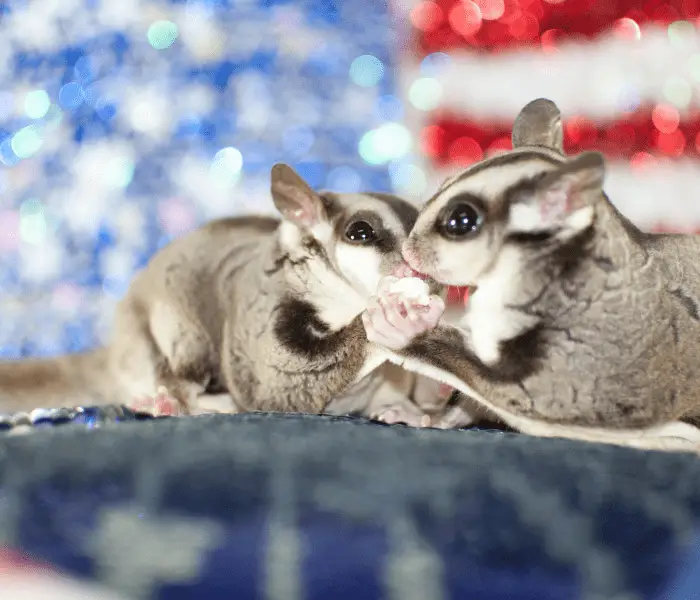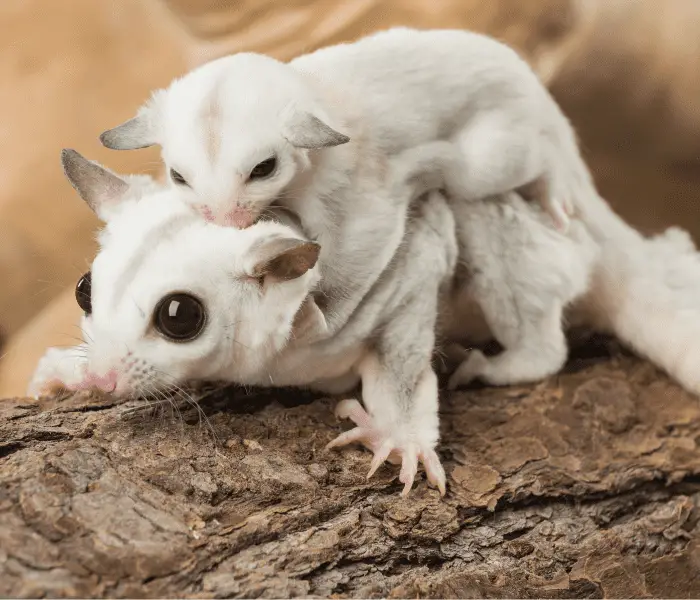Sugar glider behavior can be explained by their instinct for survival in the wild. Nature can be cruel, and we sometimes seem to forget that sugar gliders hail from forests where the living conditions do not favor the weak.
Sugar gliders will commonly eat dead colony members. This is instinctive behavior to avoid attracting predators and prevent the spread of diseases.
It can be jarring to realize that your sugar gliders have been cannibalistic, but it might help to know exactly why this behavior occurs and what you can do to prevent it.

Will Sugar Gliders Kill Each Other?
Sugar gliders may attack and kill other sugar gliders due to territorial aggression or if competing for limited resources (food or breeding mates). Sugar gliders may also show aggression to the point of killing colony members due to severe stress.
Female sugar gliders may kill their joeys due to lack of nutrition, poor mothering ability, or other causes of stress such as limited space or unstable colony hierarchy.
Cannibalism After Death Of A Colony Member
This is the most common type of cannibalism in sugar gliders. As mentioned previously, the reason is twofold.
First, they will try to consume the remains of a fellow sugar glider to ‘remove the evidence’ of the deceased colony member to avoid attracting predators such as owls and snakes in the wild.
Secondly, it prevents the spread of diseases to other sugar glider colonies. Of course, some infections may spread to other sugar gliders when they consume a colony member that succumbed to that particular disease. Still, it will prevent the spread of disease to neighboring colonies of sugar gliders. So even though the sugar gliders ‘cleaning up’ will be infected, it will protect the greater population of sugar gliders in an area.
It can be very distressing to find that one of your sugar gliders has passed and that your other gliders were busy cleaning up, but just remember that they do this due to instinct, and you can’t really blame them for wanting to do that.
Therefore, it is best to remove the body of a sugar glider that has passed as soon as possible. If you need more information on what to do after a sugar glider has passed or signs that your sugar glider might be dying, please check out the articles by clicking on the respective link.
Was My Sugar Glider Killed, Or Did He Die Of Another Cause, And Were The Other Gliders Trying To ‘Clean Up’?
The answer to this question might not always be obvious. It is less likely that your sugar glider was killed if you did not notice any inter-glider aggression. If you need a definite answer, the best would be to have a post-mortal examination (a necropsy) and histopathology (examining organ tissue under the microscope) done to determine the cause of death.
Speak to your local vet about the options to get a necropsy done. If they do not offer the service, they should be able to point you to someone who can and may be able to help with shipping if needed.
It is best to ship the body to the lab as soon as possible, as normal post-mortal changes can obscure the findings of a necropsy. Ideally, the necropsy should be done within 48 hours of death, but if the body is stored well, up to a week after death will still be acceptable.
If you cannot deliver the body to the lab immediately, place it inside a waterproof plastic bag (preferably two to prevent accidental leaking of body fluid) and keep it somewhere cool, preferably a fridge, to delay post-mortal changes that will interfere with the findings of the post mortem. DO NOT FREEZE the body.
Tissue that has been frozen and then thawed is permanently altered and will limit the examiner’s ability to perform an accurate necropsy.
In some cases, a post-mortal investigation can provide valuable information about the cause of death, but not all necropsies provide exact and definite answers. In addition, some causes of death can be complicated to determine unless advanced and often costly diagnostic tests or imaging are pursued.
Cannibalism Of Joeys (Infanticide)
Female sugar gliders may occasionally kill their joeys for a multitude of reasons, including:
- Limited resources such as food or nests
- Poor mothering ability (this is often a genetic ‘personality’ trait, and the glider should not be used for breeding again if this is suspected to be the cause of the infanticide)
- Congenital defects of the young
- Marsupial pouch infection
- Environmental stress (see the section with the linked article on stress below)
Cannibalism Due To Aggression
Sugar gliders are not very aggressive animals by nature, but there are a few instances where they might show aggression. Aggression between sugar gliders may occasionally escalate to the point of death. If this is the case, cannibalism will often follow.
6 Reasons For Inter-Sugar Glider Aggression
Let’s have a look at some of the most common reasons why sugar gliders will be aggressive:
1. Protecting Their Territory
Sugar gliders are very territorial by nature. This is why introducing new sugar gliders should always be done slowly and carefully. Never abruptly introduce a new sugar glider to an established colony.
2. Unneutered Males
Unneutered males have higher testosterone simply because they are still carrying the major testosterone-producing organ, the testes. Testosterone is a significant driver of territorial and mating-related aggression.
Having your males neutered will help to reduce this type of aggression significantly.
3. Pregnant Females or Females Carrying Joeys
A pregnant female or carrying joeys will naturally be aggressive to protect her young. Please handle the feisty lady with extra care as she has a good reason to be grumpy.

4. Competing For Limited Resources
If there is limited space in an enclosure, limited food and water, or limited nesting space, sugar gliders will feel the need to compete for these valuable resources. Luckily, food and bedding are very rarely a limited resource for pet sugar gliders.
An enclosure that is not big enough is the most common reason pet sugar gliders will become aggressive for this reason (this also relates to stress, discussed a few paragraphs down).
5. Pain
It might be common knowledge that sugar gliders will self-mutilate when they are in pain, but did you know that they may also show aggression to other sugar gliders and to their owner when they are in pain?
If one of your sugar gliders seems to be aggressive for no apparent reason, it is a good idea to have them examined by a vet who is familiar with sugar gliders to rule out any painful conditions.
6. Stress
Sugar gliders are instinctively prone to stress. Signs of stress include hiding, biting, reduced appetite, and stereotypical behavior. In extreme cases, they will show aggression.
You can help calm a sugar glider by providing them with a safe, quiet, and dark space with food and water. Sugar gliders should not be kept alone, and their environment should be conducive to their natural instincts.
To read more on what causes sugar gliders to stress and what you can do to help calm them, please have a look at this article.
Cannibalism Due to Stress
In extreme cases of stress, sugar gliders may become aggressive to the point of killing a cage mate, and, as mentioned above, they will cannibalize another sugar glider after death.
Luckily this is only seen in cases where husbandry and living conditions are deplorable or where sugar gliders are abused or have a history of abuse. Again, you can refer to this article to read more on stress in sugar gliders.
Conclusion
Cannibalism in sugar gliders are luckily relatively uncommon. To prevent this, be sure to remove the body of a sugar glider that has passed from the cage as soon as possible. It is also essential to address any potential causes of aggression to prevent sugar gliders from injuring each other.
References
- Banks, R., 2013. Exotic small mammal care and husbandry. Hoboken: John Wiley, pp. 157 – 168. https://onlinelibrary.wiley.com/doi/book/10.1002/9781119265405
- Burgess, M.E. and Bishop, C.R. (2012). Reproductive Physiology, Normal Neonatology, and Neonatal Disorders of Sugar Gliders. In Management of Pregnant and Neonatal Dogs, Cats, and Exotic Pets, C. Lopate (Ed.). https://doi.org/10.1002/9781118997215.ch17
- Dierenfeld, E., 2009. Feeding Behavior and Nutrition of the Sugar Glider (Petaurus breviceps). Veterinary Clinics of North America: Exotic Animal Practice, 12(2), pp.209-215.
- Meredith, A. and Redrobe, S., 2002. BSAVA manual of exotic pets. 4th ed. Quedgeley: British Small Animal Veterinary Association, pp. 102 – 106 25. https://www.researchgate.net/publication/240493099_The_BSAVA_Manual_of_Exotic_Pets_4th_edn
- Monchaux, M. (2019). Sugar Gliders: Husbandry and Common Diseases. Paper presented at VIII FAUNA International Conference, Lisbon, Portugal. https://hdl.handle.net/2268/260249
- Saunders, R. (2015, April). What is a sugar glider, and how do I nurse it?. In BSAVA Congress Proceedings 2015 (pp. 372-373). BSAVA Library.
